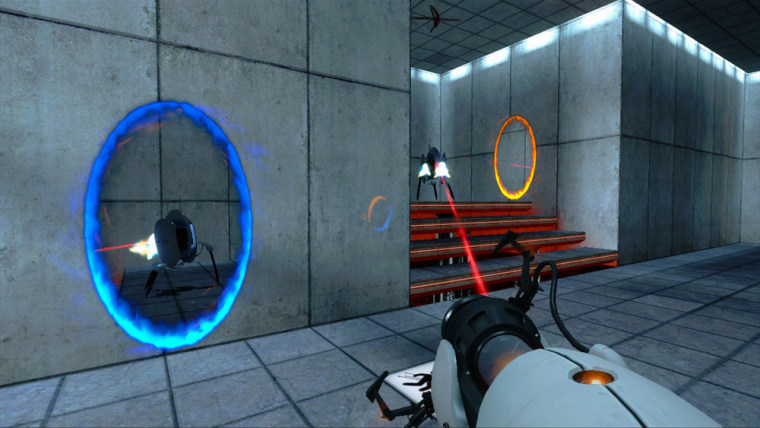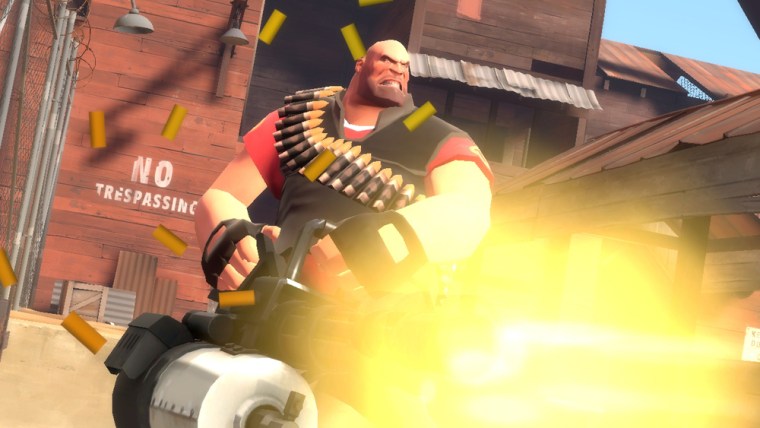When the PC games "Half-Life" and "Half-Life 2" launched in 1998 and 2004 respectively, they heralded a fresh, hybrid style of action game: the cerebral shooter.
Other first-person shooters might have had token puzzles to spice things up (find a key in "Doom II" or hop on a box in "Deus Ex") but no game had integrated situations that required you to stop and think like the "Half-Life" games. (If you had time to stop and think while you were blasting the heads off of zombies, that is.)
With "The Orange Box," developer Valve Software offers a bountiful collection of previously-released and brand new game material for both PC and next-gen console gamers. Included in the package are "Half-Life 2" and "Half-Life 2: Episode One" as well as the new "Half-Life 2: Episode Two," "Portal" and (whew!) "Team Fortress 2."
At the tail end of a four-night-long marathon, having plumbed the depths of "The Orange Box," I can't remember having a better time gaming. Whether you're a "Half-Life" completist or just want to stretch the heck out of your game dollars, obtain this excellent collection.
PC gamers can either buy the full retail package today for $49.99 or download the games through Valve's Steam service — www.steampowered.com — at the same price. Xbox 360 owners are in for a treat since none of "The Orange Box" goodness has appeared on a next-gen console before. "The Orange Box" is available for the Xbox 360 today for $59.99. PS3 loyalists, already used to waiting, should have theirs by the end of the year.
Commencing with the main course, let's start at the "Half-Life 2" end of the buffet table. If you're a newcomer to the series, a quick plot re-cap is in order. Our hero Gordon Freeman, the strong, silent type, is a theoretical physicist who's quite capable of kicking some serious butt. He spends his time during "Half-Life" trying to undo the damage caused by a botched experiment at the top-secret Black Mesa Research Facility. It seems that fiddling around with time and space has its consequences. At the close of "Half-Life," Gordon is put into stasis by a mysterious character known colloquially as G-Man.
"Half-Life 2" is where the material starts to come into its own. The characters and storyline benefit immensely thanks to deft writing and almost distractingly realistic character and facial animations. "Half-Life 2" sees Freeman revived and facing off against the Combine — enemies from another dimension who have taken over Earth. He's aided by human resistance fighters and scientists. All this scientific tomfoolery with mother nature has also unleashed legions of zombies, insectoid mutations and assorted beasties which means there's never a dull moment for Gordon.

Suffice it to say that "Half-Life 2" and the subsequent episodic sequels, the first two included here, are tales imbued with a haute-pulp, sci-fi flavor. The humor and rich characters set the material heads and shoulders above gaming's usually flat, predictable fare. Here are characters you'll care about.
For the Xbox 360 version of "The Orange Box," Valve has gone back and given "Half-Life 2" and "Episode One" a shiny new coat of paint — motion blur, higher quality fire and lighting effects and increased surface texture details are immediately noticeable.

Gordon's partner Alyx is even more life-like, complete with subtle facial expressions and context-specific comments. If Gordon is driving erratically she might laugh at him or express gratitude for not getting car sick.
The 360's controller, while certainly less precise than a PC mouse, does a competent job with aiming and navigating. The inventory screen can be clumsy to operate, so it's best to have your weapon of choice equipped before a firefight. More often than not, you'll be packing "Half-Life's" trademark Gravity Gun for no other reason than it's so darned fun. One controller trigger picks up objects and the other launches them. Few things in life are more satisfying than hurling a fuel barrel into the face of a Combine Hunter machine.
As far as "The Orange Box's" new material goes, "Half-Life 2: Episode Two," stars Gordon and Alyx and follows the two as they assist the resistance in shutting down an inter-dimensional rift the Combine are using as an elevator between their world and Earth. We also witness a budding romance develop between our two heroes.
When was the last time you had an emotional investment in a game? We don't want to reveal too much, but a tear might just be shed before the credits roll in "Episode Two."
Meanwhile, the puzzles, like in the previous installments, are thoughtfully designed and logical. Gordon may have to manipulate the environment with the Gravity Gun to reach an objective or figure out how to best destroy giant Combine Walkers. The level of difficulty is nicely tuned to avoid controller-launching frustration.
Take time to explore 'Portal'
"Team Fortress 2" may well be the other main attraction in "The Orange Box," but it would be a crying shame to skip by "Portal." The game started out as a student project at the DigiPen Institute of Technology but in its final form, "Portal" has been cleverly incorporated into the "Half-Life" universe.
Here you play a female test subject at Aperture Labs, a Combine facility that shows up toward the end of "Episode Two." The player is tasked with navigating to an exit in a series of rooms. Sounds simple enough, right? Well, the trick is that the layout of the levels, some complete with gun turrets, toxic pools and complex switch systems, requires the use of an arm-mounted device that creates portals. The device shoots two types of energy to make blue and orange portals.
When you enter the blue portal you exit the orange and vice versa. Once you wrap your head around the concept — call it portal-thinking — the possibilities are, literally, dizzying. Most flat surfaces in the multi-level rooms are portal-ready, be it on the ceiling, on the floor 300 feet below you or underneath a gun turret.
The side-splittingly funny computer A.I. that guides — and deceives — you on your journey briefs you on a crucial physics principal: Fast goes in the portal, fast comes out the portal. So if you need to launch yourself across an area, make one portal on the floor far below you and another on an angled surface above you. As your speeding body falls through the first portal you are instantly launched from the second at the same speed. Voila! Human rocket. By the time the game takes a decidedly darker turn in the final segment you'll be slinging portals every which way like a pro.

Take the time to explore "Portal." The sense of accomplishment and the first-rate dialog it delivers are intensely rewarding.
Last, as they say, but certainly not least is "Team Fortress 2." This multi-player blast-a-thon has been in development for years and started life as a realistic shooter a la "Battlefield." What we ended up with, thankfully, looks like a Wile E. Coyote and Roadrunner episode populated by psychotic caricatures.
The graphical approach is striking and quite unlike any other online shooter. Since the environment seems to be made up of 3D objects, there's a visual depth to the game that's missing from some of the cel-shaded, cartoon games such as "Okami" or "Jet Set Radio."
As far as the online play goes, "Team Fortress 2," supporting up to 16 players, offers up class-based combat. Instead of the usual sniper-engineer-soldier-medic formula, here we have nine characters to choose from. Take your pick from the Scout (fast but relatively frail), the Heavy (a hulking figure with a chain gun), the Pyro (specializing in the crispy recipe), and others.
The varied cast will keep players coming back, even with just six maps and mostly territory or capture-point game play. The mix and match possibilities on a team can spell victory or disaster — try a Medic and Heavy tag team or send out your Spies to don the enemies' colors and infiltrate their defenses.
"The Orange Box" pulls out all the stops. The "Half-Life 2" headliner together with the sublime action/puzzler "Portal" and insanely fun "Team Fortress 2" make it a crucial purchase for nearly any gamer. Fifty-odd bucks have never seemed so reasonable.
